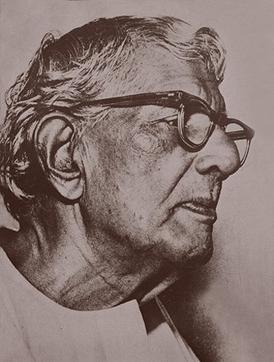
Jamini Roy was an Indian painter. He was honoured by the Government of India the award of Padma Bhushan in 1954. He remains one of the most famous pupils of Abanindranath Tagore, another praised Indian artist and instructor. Roy's highly simplified, flattened-out style, and reminiscent of European modern art was influenced by the “bazaar” paintings sold at Indian temples as talismans.
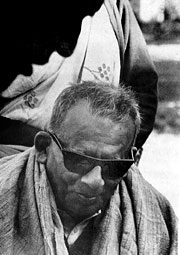
Benode Behari Mukherjee was an Indian artist from West Bengal state. Mukherjee was one of the pioneers of Indian modern art and a key figure of Contextual Modernism. He was one of the earliest artists in modern India to take up to murals as a mode of artistic expression. All his murals depict a subtle understanding of environmental through pioneering architectural nuances.

Ganesh Pyne was an Indian painter and draughtsman, born in Kolkata, West Bengal. Pyne is one of the most notable contemporary artists of the Bengal School of Art, who had also developed his own style of "poetic surrealism", fantasy and dark imagery, around the themes of Bengali folklore and mythology.

Somnath Hore (1921-2006) was an Indian sculptor and printmaker. His sketches, sculptures and prints were a reaction to major historical crises and events of 20th century Bengal, such as the Bengal Famine of 1943 and the Tebhaga movement. He was a recipient of the Indian civilian honour of the Padma Bhushan.
Hiran Mitra is an artist based in Kolkata. He left his ancestral country home in Kharagpur to study Fine Art in the Government College of Art & Craft, Kolkata at the age of 14. His paintings are energetic abstract gestural paintings with the choreography of the human body observed from folk dance having influenced his recent calligraphic forms. He has contributed significantly to the visual stimulus in eastern Indian films, television, theatre and literature since in the 1980s [. He is also known to have defined a benchmark for book cover design for contemporary Bengali literature. His paintings are statements on the human condition and the twilight zones of reality and time. Bold brush strokes, layered washes and sprays and unconventional use of acrylic and industrial paints characterize his paintings. He is part of the Open Window Artist group and has been part of the Painters 80 Artist group in Kolkata.

Bikash Bhattacharjee was an Indian painter from Kolkata in West Bengal. Through his paintings, he depicted the life of the average middle-class Bengali – their aspirations, superstitions, hypocrisy and corruption, and even the violence that is endemic to Kolkata. He worked in oils, acrylics, water-colours, conté and collage. In 2003, he was awarded the highest award of Lalit Kala Akademi, India's National Academy of Arts, the Lalit Kala Akademi Fellowship.
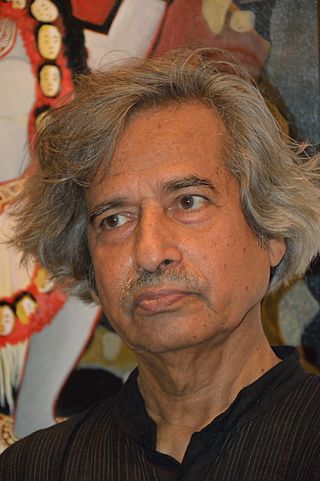
Jogen Chowdhury is an eminent Indian painter and considered an important painter of 21st century India. He lives and works in Santiniketan. He graduated from the Government College of Art & Craft, Kolkata and subsequently at École nationale supérieure des Beaux-Arts, Paris in 1967. He has immense contribution in inspiring young artists of India. Jogen Chowdhury had developed his individual style after his return from Paris. His most famous paintings are in ink, water colour and pastel. He has painted in oil medium as well.
Harendra Narayan Das, better known as Haren Das, was a highly respected artist in India who worked almost exclusively in printmaking mediums. His work included engravings, linocuts, etchings, and lithographs, though he is most remembered for the technical skill of his woodcuts and wood engravings.

The Government College of Art & Craft (GCAC) in Kolkata is one of the oldest Art colleges in India. It was founded on August 16, 1854 at Garanhata, Chitpur, "with the purpose of establishing an institution for teaching the youth of all classes, industrial art based on scientific methods." as the School of Industrial Art. The institute was later renamed as the Government School of Art and in 1951 it became the Government College of Art & Craft.
Sunil Das was an Indian expressionist painter. He is known for the paintings in his Bull Series and his piece "Woman".

David McCutchion was an English-born academic, and a pioneer in a number of original strands of scholarship in Indian studies before his early death at age 41. Popularly known as "Davidbabu", in his short life, he made a major contribution to the study of Hindu terracotta and brick temples of Bengal and was also one of the first scholars to write a study of the emerging field of Indian writing in English.

Rabin Mondal, born as Rabindra Nath Mondal, was an Indian painter from Howrah, West Bengal. He was an Indian artist who was a founding member of the Calcutta Painters. He lived and worked in relative obscurity until retrospective exhibitions of his work in Kolkata, New Delhi and Bombay brought him to India's national attention in 2005.

Maharaja Bahadur Sir Prodyot Coomar Tagore KCIE was a leading land owner, philanthropist, art collector, and photographer in Kolkata, India. He belonged to the Pathuriaghata branch of the Tagore family.
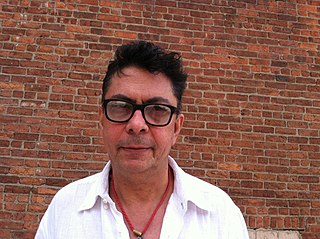
Chittrovanu Mazumdar is a contemporary Indian artist of Bengali-Indian and French descent. Mazumdar has been described as a "conceptual artist" and a "post-structuralist" while some critics consider it difficult to classify his oeuvre into a single artistic tradition or even into any consistent genre of his own. Mazudmar has referred to himself as an "expressionist painter" but has also said he generally prefers not to use "a particular word to qualify" his work because it comprises different kinds of media and forms, and that art is more interesting when fully given over to the viewer's own experience rather than constrained by the prescriptive power of labels.
Somenath Maity is an Indian artist known for his oil paintings of urban landscapes.

Raman Siva Kumar, known as R. Siva Kumar, is an Indian contemporary art historian, art critic, and curator. His major research has been in the area of early Indian modernism with special focus on the Santiniketan School. He has written several important books, lectured widely on modern Indian art and contributed articles to prestigious international projects such as the Art Journal, Grove Art Online or The Dictionary of Art, Oxford University Press.
Uma Bardhan is an Indian contemporary artist. Her paintings are usually themed on stories and positions which are under-represented in both mainstream and contemporary art culture. Her preferred medium is water color on silk, and she has also worked in other media, including oil on canvas. Her paintings are in several major collections in India & abroad. Her works has been hugely inspired by her formative years in Kolkata and her deep belief in spirituality. Originally from Kolkata she lives & works in Gurgaon, Haryana
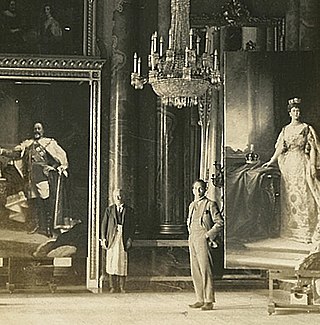
Atul Basu was an Indian painter. He was an expert in portraying realistic landscapes, portraits and village scenery. He used oil colors for painting.

Sunayani Devi was an Indian painter born into the aristocratic Tagore family in Calcutta, West Bengal. She was a self taught artist, with no academic training in art. Inspired by her brothers, Abanindranath Tagore, Gaganendranath Tagore, and Samarendranath Tagore, she started painting only at the age of 30. She was married at the age of 12 to the grandson of Raja Ram Mohan Roy.
Reba Hore (1926–2008) was an Indian artist and activist. She has worked in various mediums ranging from water colors, mixed media, oil paints, pastels to terracotta. Her artworks were spontaneous, deeply personal and rooted in her daily life experiences. She was the wife of Somnath Hore, an accomplished sculptor and print maker himself.













